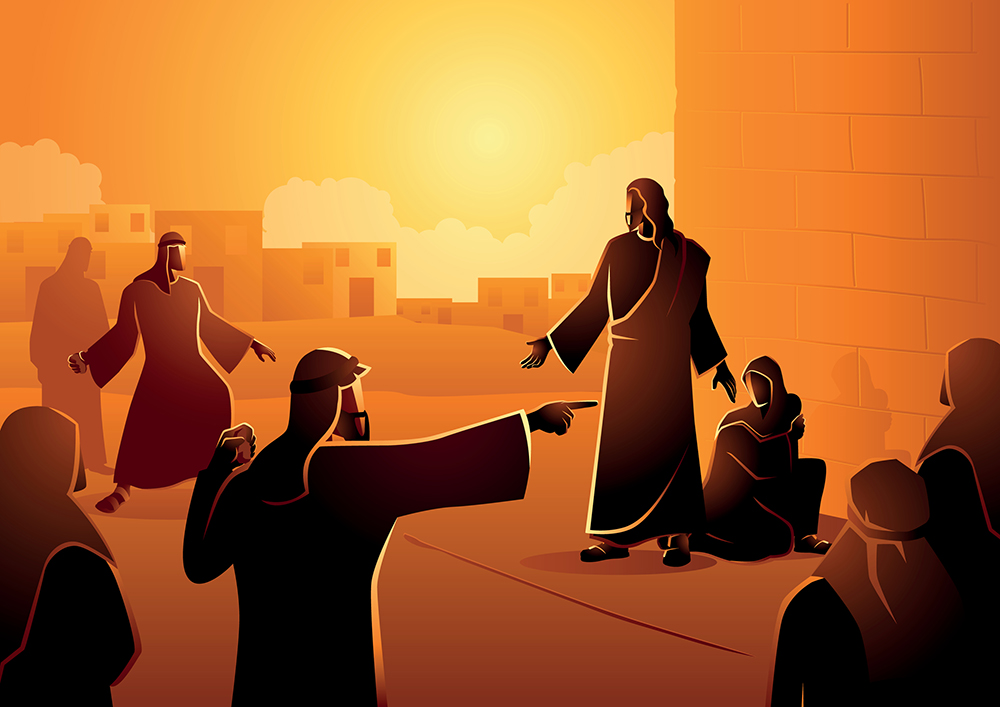This post is part of an ongoing series in the study of John we are doing during January. Subscribe to the blog for daily updates in the Bible Study posts. Subscribe to the podcasts to hear our discussion of the book of John throughout this month. Join us in your daily devotions as we travel through this fascinating account of the life of Christ.
***
1 But Jesus went to the Mount of Olives. 2 Now early in the morning He came again into the temple, and all the people came to Him; and He sat down and taught them. 3 Then the scribes and Pharisees brought to Him a woman caught in adultery. And when they had set her in the midst, 4 they said to Him, “Teacher, this woman was caught in adultery, in the very act. 5 Now Moses, in the law, commanded us that such should be stoned. But what do You say?” 6 This they said, testing Him, that they might have something of which to accuse Him. But Jesus stooped down and wrote on the ground with His finger, as though He did not hear. 7 So when they continued asking Him, He raised Himself up and said to them, “He who is without sin among you, let him throw a stone at her first.” 8 And again He stooped down and wrote on the ground. 9 Then those who heard it, being convicted by their conscience, went out one by one, beginning with the oldest even to the last. And Jesus was left alone, and the woman standing in the midst. 10 When Jesus had raised Himself up and saw no one but the woman, He said to her, “Woman, where are those accusers of yours? Has no one condemned you?” 11 She said, “No one, Lord.” And Jesus said to her, “Neither do I condemn you; go and sin no more.” John 8:1-11 (NKJV)
Is This Passage Real?
Most study Bibles include a note related to this passage that suggests the earliest manuscripts of the Bible do not include these verses. So does that mean this story of Jesus and the woman caught in the act of adultery, one of the most famous stories of the gospel, is not real and should not be in the Bible?
The earliest Greek manuscripts of the New Testament did not include this passage of the gospel. Still, the early church accepted this account as legitimate and one of the many testimonies of Jesus when the New Testament was compiled. The passage does not, in any way, conflict with other teachings and stories included in the New Testament, which was a significant factor in determining what was included in the final canon of the New Testament in 398 AD at the Council of Carthage.
The truth and accuracy of this passage are not debated. What is generally debated among scholars is why this passage was included at this point in the gospel of John. It appears to interrupt the dialogue taking place between Jesus and the people going on in chapter 7. When we look at the last verse of chapter 7 and connect it to verse 12 in chapter 8, we find a better flow.
The passage is real, and it is Biblical, but the section of chapter 8:1-11 was probably inserted at the wrong place in the gospel of John. None of this should give us cause to doubt the significance of what unfolds in this passage.
If you would like to learn more about how the New Testament was compiled and canonized, you might enjoy my book, Understanding the Word of God.
The Trap
The trap set by the religious leaders for Jesus in this passage is implicit but let’s examine it to be clear. When they brought the woman caught in the act of adultery publicly to Jesus, they believed they had Him caught in an impossible predicament. It is worth noting how little they appeared to care for the woman who was merely an object in their political game to trap Jesus.
If Jesus upheld His reputation for mercy and forgiveness by pardoning the woman, then the religious leaders knew they had Him caught in a contradiction to the Law of God, which ordered that adulterers should be stoned to death. (Incidentally, it is worth noting that if she was caught in the act of adultery, then the man she committed adultery with should also have been easily brought publicly before Jesus as she was.) If, however, Jesus backed the law of Moses and advised the woman should be stoned, then the religious leaders could report Jesus to the Roman authorities for inciting a rebellion as only the Roman authorities had the legal right to order execution at that time in Palestine.
The trap was set, but Jesus saw through it.
Missing the Point
The story is so familiar to most of us that we can easily imagine Jesus’s frustration and perhaps even disappointment. Not only does He see through the trap set by the religious leaders. He sees how badly they have missed the point.
God did not give the Law to condemn mankind. He gave the Law to provide a pathway out of darkness and death to light and life. The fact that the people could not live up to the standards of the Law was one thing, but these religious leaders were going much farther than that. They were using the law as a weapon to condemn rather than a doorway to life.
For the law was given through Moses, but grace and truth came through Jesus Christ. John 1:17 (NKJV)
Jesus did not pardon the woman. He also did not condemn her. Once the accusers were gone, He pushed her toward a new way of life.
“Woman, where are those accusers of yours? Has no one condemned you?” She said, “No one, Lord.” And Jesus said to her, “Neither do I condemn you; go and sin no more.”
Free From Condemnation
Scripture holds a surprisingly small number of references to Satan, but when we see him in scripture, he is often found accusing us of things before God. (See Job 1 and Revelation 12:10 as examples of this.) The standard of Jesus silences the Accuser in our life before the throne room of God. That does not mean we have lived perfect lives. It means the power of the Accuser to condemn us for our imperfections is no longer potent. Like the religious leaders who stood before Jesus that day in John 8, the one who seeks to condemn us has been removed from a place of authority in our life.
Instead, we have the grace and truth of Christ, which offers a doorway to a new way of living, free of both accusers and condemnation. The new way of Christ is full of grace and truth, which propels us toward a transformation lifestyle.
There is therefore now no condemnation to those who are in Christ Jesus, who do not walk according to the flesh, but according to the Spirit. For the law of the Spirit of life in Christ Jesus has made me free from the law of sin and death. Romans 8:1-2 (NKJV)






What do you think?
Show comments / Leave a comment